The ARM vs x86 Wars Have Begun: In-Depth Power Analysis of Atom, Krait & Cortex A15
by Anand Lal Shimpi on January 4, 2013 7:32 AM EST- Posted in
- Tablets
- Intel
- Samsung
- Arm
- Cortex A15
- Smartphones
- Mobile
- SoCs
What's Next? ARM's Cortex A15
Comparing to Qualcomm's APQ8060A gives us a much better idea of how Atom fares in the modern world. Like Intel, Qualcomm appears to prioritize single threaded performance and builds its SoCs on a leading edge LP process. If this were the middle of 2012, the Qualcomm comparison is where we'd stop however this is a new year and there's a new kid in town: ARM's Cortex A15.
We've already looked at Cortex A15 performance and found it to be astounding. While Intel's 5-year old Atom core can still outperform most of the other ARM based designs on the market, the Cortex A15 easily outperforms it. But at what power cost?
To find out, we looked at a Google Nexus 10 featuring a Samsung Exynos 5250 SoC. The 5250 (aka Exynos 5 Dual) features two ARM Cortex A15s running at up to 1.7GHz, coupled with an ARM Mali-T604 GPU. The testing methodology remains identical.
Idle Power
As the Exynos 5250 isn't running Windows RT, we don't need to go through the same song and dance to wait for live tiles to stop animating. The Android home screen is static to begin with, all swings in power consumption have more to do with WiFi at this point:
At idle, the Nexus 10 platform uses more power than any of the other tablets. This shouldn't be too surprising as the display requires much more power, I don't think we can draw any conclusions about the SoC just yet. But just to be sure, let's look at power delivery to the 5250's CPU and GPU blocks themselves:
Ah the wonderful world of power gating. Despite having much more power hungry CPU cores, when they're doing nothing the ARM Cortex A15 looks no different than Atom or even Krait.
Mali-T604 looks excellent here. With virtually nothing happening on the display the GPU doesn't have a lot of work to do to begin with, I believe we're also seeing some of the benefits of Samsung's 32nm LP (HK+MG) process.
Remove WiFi from the equation and things remain fairly similar, total platform power is high thanks to a more power hungry display but at the SoC level idle power consumption is competitive. The GPU power consumption continues to be amazing, although it's possible that Samsung simply doesn't dangle as much off of the GPU power rail as the competitors.


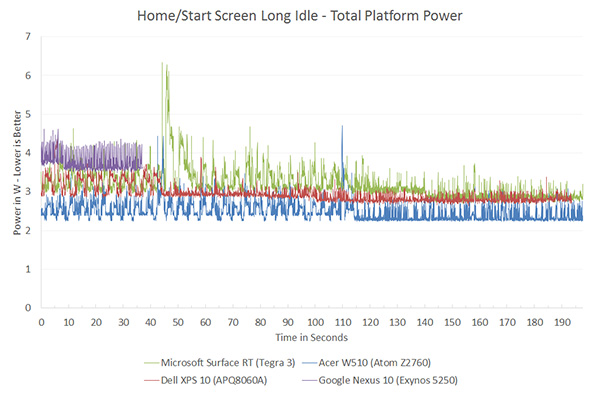
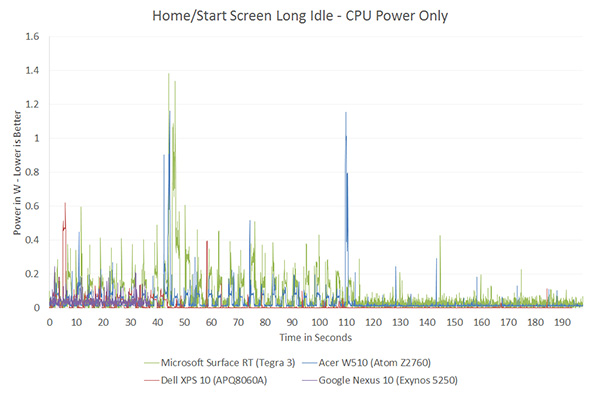
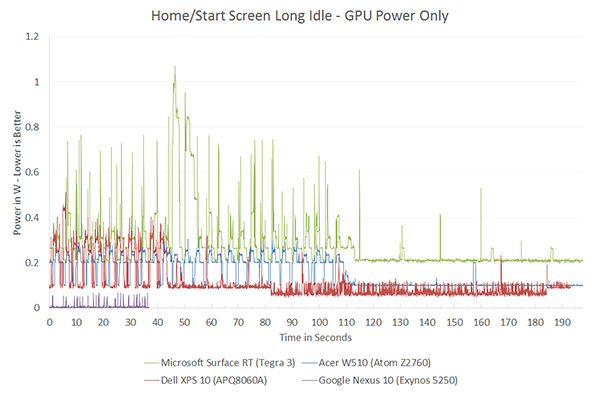
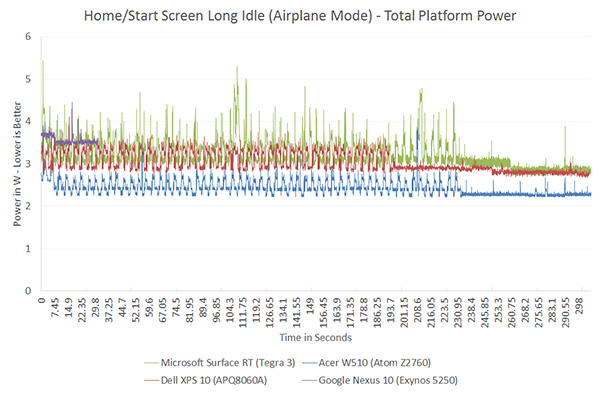
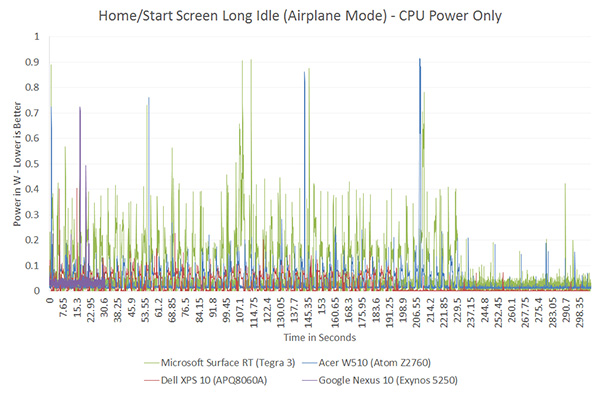
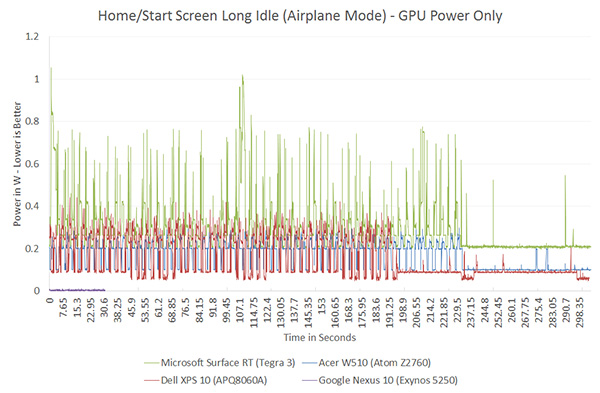








140 Comments
View All Comments
djgandy - Friday, January 4, 2013 - link
People care about battery life though. If you can run faster and go idle lower you can save more power.The next few years will be interesting and once everyone is on the same process, there will be less variables to find to assert who has the most efficient SOC.
DesktopMan - Friday, January 4, 2013 - link
"and once everyone is on the same process"Intel will keep their fabs so unless everybody else suddenly start using theirs it doesn't look like this will ever happen. Even at the same transistor size there are large differences between fab methods.
jemima puddle-duck - Friday, January 4, 2013 - link
Everyone cares about battery life, but it would take orders of magnitudes of improvement for people to actually go out of their way and demand it.Wolfpup - Friday, January 4, 2013 - link
No it wouldn't. People want new devices all the time with far less.And Atom swaps in for ARM pretty easily on Android, and is actually a huge selling point on the Windows side, given it can just plain do a lot more than ARM.
DesktopMan - Friday, January 4, 2013 - link
The same power tests during hardware based video playback would also be very useful. I'm disappointed in the playback time I get on the Nexus 10, and I'm not sure if I should blame the display, the SOC, or both.djgandy - Friday, January 4, 2013 - link
It's probably the display. Video decode usually shuts most things off except the video decoder. Anand has already done Video decode analysis in other articles.jwcalla - Friday, January 4, 2013 - link
You can check your battery usage meter to verify, but... in typical usage, the display takes up by far the largest swath of power. And in standby, it's the wi-fi and cell radios hitting the battery the most.So SoC power efficiency is important, but the SoC is rarely the top offender.
Drazick - Friday, January 4, 2013 - link
Why don't you keep it updated?iwod - Friday, January 4, 2013 - link
I dont think no one, or no anandtech reader with some technical knowledge in its mind, has ever doubt what Intel is able to come up with. A low power, similar performance or even better SoC in both aspect. Give it time Intel will get there. I dont think anyone should disagree with that.But i dont think that is Intel's problem at all. It is how they are going to sell this chip when Apple and Samsung are making one themselves for less then $20. Samsung owns nearly majority of the Android Market, Which means there is zero chance they are using a Intel SoC since they design AND manufacture the chip all by themselves. And when Samsung owns the top end of the market, the lower end are being filled by EVEN cheaper ARM SoCs.
So while Intel may have the best SoC 5 years down the road, I just dont see how they fit in in Smartphone Market. ( Tablet would be a different story and they should do alright.... )
jemima puddle-duck - Friday, January 4, 2013 - link
Exactly. Sometimes, whilst I enjoy reading these articles, it feels like the "How many angels can dance on the head of a pin" argument. Everyone knows Intel will come up with the fastest processor eventually. But why are we always told to wait for the next generation? It's just PR. Enjoyable PR, but PR none the less.